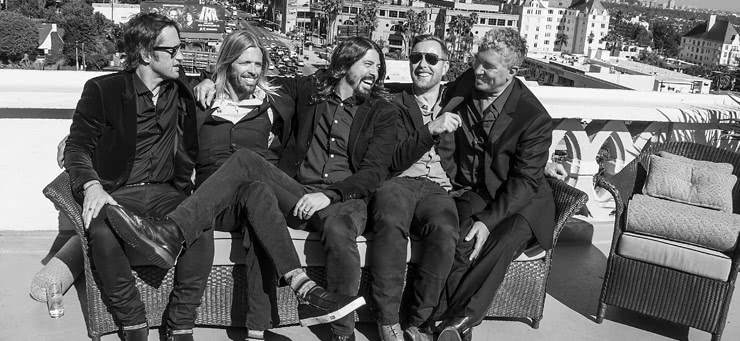From little things, big things grow. We’re talking really, really big things here, too. In 1994, roughly six months after the demise of his previous band, a guy walked into a Seattle studio for a few days and recorded an album almost entirely on his own. Fast-forward to the present day, and Dave Grohl’s humble one-man project has expanded into a five-man entity that feels both omnipotent and omnipresent in the greater spectrum of rock music; one that’s gone on to span a further six albums, countless radio hits and even a theatrically released documentary.
We now arrive at album number eight for the Foo Fighters, and in typical Foo Fighters style, it’s not something that’s been done by half measures. The album’s eight tracks were each recorded separately in eight different American cities, with the entire process being documented for an HBO series.
“It started out just making lists – we were just thinking of studios we wanted to record at, all over the world,” says guitarist Pat Smear, here working on his third Foo Fighters record overall following 1997’s The Colour And The Shape and the band’s most recent LP, 2011’s Wasting Light. “From that, we narrowed it down to just US cities. We thought it should be studios that weren’t super-exposed and doing really well. Maybe it would be the last chance we were going to get to work there, or maybe it had a personal meaning to someone in the band – the Seattle studio, for example, where Dave recorded the last Nirvana songs and the first Foo Fighters album.”
“It would have been fun to travel around the world making this album,” adds Chris Shiflett, the lead guitarist who joined shortly after the release of the band’s third album, There Is Nothing Left To Lose. “If we’d done that, though, we’d probably still be making the album. This was just about what made the most sense to us as a band.”
Sonic Highways’ intention is to reflect the feelings and emotions connected with each city. It’s a record that is steeped heavily in vintage rock sounds and textures, recalling acts like The Who and the Eagles, as well as notable major influences on Grohl such as Led Zeppelin and Tom Petty. That being said, Smear is quick to stress that the band wasn’t setting out to emulate these giants – even if songs did manage to end up there.
“Between the five of us in the band, we collectively seem to love every classic rock band that there is,” he says. “Anything that came out that’s reflective of that, though, is honestly pretty accidental. That’s just us, y’know? We didn’t set out and say we were going to do a song like so and so, but we might look back on a song and realise it’s a Who rip-off. We also get people telling us what they hear in the music, and a lot of the time it’s like, ‘Oh! I hadn’t thought of that. I can see that.’”
The album is also notable for being the second Foo Fighters record to feature three guitarists. For the bulk of the band’s career, everything has worked off a two-guitar dynamic. This changed, however, with the return of Smear to the fold on the Skin And Bones tour after he initially left the band in 1997. Wasting Light was the first album to feature Grohl, Smear and Shiflett all together under the one proverbial roof, and their triangulated six-string attack plan continues to develop on Sonic Highways.
“I think the trick is when we’re working on new music, we try not to step on each other’s toes,” says Shiflett. “A lot of the time, we’re hammering away on the same power chords, but we do try and map it out so that everyone is playing something different. Maybe I’ll be playing some melody line, Pat will be holding down the rhythm and Dave will be playing some chords that steer the song. It all just depends on what the song needs. It’s never really a big discussion – it’s all in the way that we play.”
The visual aspect of Sonic Highways follows on from the band’s appearance in Grohl’s Sound City documentary from last year about the famed Los Angeles studio of the same name, which itself followed on from 2011’s Foo Fighters: Back And Forth, the documentary tracking the history of the band. It feels as though every move the Foo Fighters make these days is being captured for the world to see – and it’s an aspect of the band that’s far from lost on its members.
“This was a little different to the documentary,” says Shiflett. “The crew for the documentary wasn’t there all the time. This time, the cameras were on every moment we were in the studio. We just became friends with all of them, so it was pretty comfortable – although I don’t think I’ll ever be able to get to the point where I cannot notice that they’re there. I’ve always got to make sure that I’m not saying anything that I wouldn’t want my mum or my kids to hear.”
“A huge part of this project has been the idea that your environment influences the music that you make,” adds Smear. “Part of our environment is constantly being miked up and having cameras around us all the time. For the third project in a row – including Sound City – it’s been like that. I think we’re pretty used to it by now, but I can guarantee you that it’s altered me in some way. I couldn’t tell you how, but maybe it’s got something to do with being more self-conscious.”
It’s rare that a band is afforded such luxury that it’s able to travel around and work in more than one studio on a single release, let alone eight. Then again, when you’ve been at the top of the food chain for so long, perhaps it’s your God-given right to indulge a little. As far as the Foo Fighters are concerned, changing things up in this respect was just another way to keep themselves on their collective toes. “We’re just trying to keep it interesting and exciting for us,” says Smear. “Dave always tries to make an adventure out of it. He’s always coming up with ideas to keep the whole thing fun. We have a studio and it’s a nice studio – we could have just cut the whole thing there. We wanted to do something that would stretch us in one way or another, as well as something that we would enjoy. It’s an important thing for us.”
“I wouldn’t really call this record a back-to-basics record,” adds Shiflett. “The way we did it was kind of on a grander scale, and we had a heap of special guests come in and play on it. At the end of the day, though, when I listen to it, it doesn’t sound like a difficult concept record. It sounds like the Foo Fighters. It sounds like a rock’n’roll record.”
Sonic Highways is out Friday November 10 through Roswell / Sony. Catch them live withRise Against and The Delta Riggs atANZ StadiumonThursday February 26, tickets online.


































